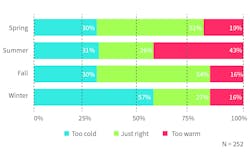Survey Goes Behind the Lines of Office HVAC ‘Thermostat Wars’
Software Advice, provider of reviews and research on software applications, recently surveyed U.S. office workers to gauge employee preferences regarding office temperature, what temperature thermostats should be set to, and how new technology can provide an effective solution.
Half of the workers Software Advice surveyed are dissatisfied with their office’s temperature several times a month or more, with 10 percent feeling dissatisfied “every day” (Figure 1), Forrest Burnson , market research associate for Software Advice, says in the report “How to Improve Employee Morale and Productivity Through Smart Climate Control.”
This dissatisfaction is heavily influenced by the time of year: A majority of respondents said their office temperature is “just right” during the more temperate seasons of fall and spring (54 and 51 percent, respectively). Conversely, 57 percent said their offices are “too cold” during winter, and 43 percent said their offices are “too hot” during summer. By far, summer was shown to be the most divisive season, with the fewest employees (26 percent) saying their office temperature is “just right” (Figure 2).
Forty Percent of Employees Have No Control Over Office Temperature
According to the survey, 40 percent of employees have no control over their office’s temperature, while just 24 percent are able to physically change the thermostat (Figure 3).
Burnson says some newer climate-control systems offer a potential solution by giving each employee a “vote” regarding thermostat setting:
• One solution integrates with an office’s HVAC system and allows employees to request via smartphone or Web browser to have the space warmed or cooled. The catch? Blasts of warm or cool air are limited to 10 min. To subtly encourage compromise and communication, employee requests are made visible to everyone in the heating and cooling “zone.” Over time, the software analyzes usage habits for each occupant, “learns” workday patterns, and then tailors heating and cooling flows accordingly, optimizing them to be as efficient as possible.
• Another type of “smart” thermostat detects usage patterns within an office and regulates temperature automatically. Employees are given access to the thermostat via smartphone app and Web browser. Though this solution is used primarily in smaller offices, several companies target large commercial buildings.
• Through an online suggestion-box tool, employees submit ideas to management in a platform similar to a forum. The ideas are put up for discussion, rated by other employees, and subsequently reviewed.
Most Say Greater Temperature Control Would Boost Productivity and Morale
A clear majority of respondents said having more control over their office’s thermostat would positively impact both their productivity and morale (figures 4 and 5).
A multitude of studies have observed a strong relationship between office temperature and worker productivity, Burnson says, adding one found a 2-percent decrease in productivity for every degree above 77°F.
Temperature Preferences Divided Along Age and Gender LinesAmong men, the median preferred temperature is 70°F; among women, it is 72°F. While that may not seem like an extreme difference, Burnson says, consider that 23 percent of women in the sample prefer a temperature between 75°F and 80°F, compared with just 5 percent of men (Figure 6).
Older Workers Are More Frequently Dissatisfied With Office Temperature
According to the survey, dissatisfaction with office temperature tends to increase with age.
Among 18- to 25-year-olds and 26- to 35-year-olds, only 32 and 34 percent, respectively, express frequent (several times a week or more) dissatisfaction with their office’s temperature. Among 46- to 55-year-olds, 69 percent are frequently dissatisfied (Figure 7).
A possible solution to the gender and age divide is to provide different temperature zones throughout an office and allow employees to work where they are most comfortable, Burnson says.
Burnson suggests companies consider:
- Conducting an anonymous online poll or survey to determine employees’ temperature preferences.
- Evaluating new software and technology solutions.
- Encouraging employees to speak up if they are uncomfortable and relocating them to a different part of the office.
For the full report, click here.








